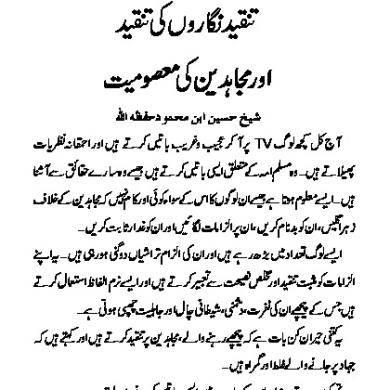Indian Mujahideen
This document was uploaded by user and they confirmed that they have the permission to share it. If you are author or own the copyright of this book, please report to us by using this DMCA report form. Report DMCA
Overview
Download & View Indian Mujahideen as PDF for free.
More details
- Words: 573
- Pages: 2
Indian Mujahideen “We the Indian Mujahideen, ask Allah, the Almighty, to accept from us these nine explosions which were planned to be executed in the holy month of Ramadan,” states a 13-page manifesto and video slide-show e-mailed by the Indian Mujahideen to media in the midst of the bombings. Charging Indians with harbouring “never ending hostile hatred in your hearts against Islam and its people,” the manifesto says that the bombings are intended to “prove to you the ability and potential of [the] Indian Mujahideen to assault any city of India at any time.” It promises that more terror attacks fill follow “to punish you even before your earlier wounds have healed.” Much of the manifesto is devoted to holding out threats to the police and media. It states: “Be it the ATS [Anti-Terrorism Squad] of Maharashtra, the ATS and ACB of Gujarat, the OCTOPUS [Organisation for Countering Terrorists] of Andhra Pradesh, or be it a psychological propaganda war by the biased media, none shall be spared when it comes to vengeance – the Qisas.” For the first time, the Indian Mujahideen makes reference to the conflict in Jammu and Kashmir. “The injustice and pain inflicted on Kashmiri Muslims during the Amarnath crisis has once again landed you in great trouble,” it warns. Describing the Delhi bombings as “a tribute to all our brethren martyrs in Kashmir,” the Indian Mujahideen says, “We announce that from now on, Inshallah, the Muslims won’t cry alone, our women won’t be widowed alone, our children won’t balone [sic., be alone] and scores will be settled evenly.” Interestingly, in an evident response to anti-jihadist clerics who have in recent months attacked the Indian Mujahideen, the e-mail lays claim to the legacy of famous regional jihadists. “We have carried out this attack in the memory of two most eminent Mujahids of India, Sayyed Ahmed, Shaheed and Shah Ismail, Shaheed (may Allah bestow His Mercy upon them), who had raised the glorious banner of Jihad against the disbelievers in this very city of Delhi.” Sayyid Ahmad of Rai Bareilly and Shah Ismail died at Balakote, Pakistan-administered Kashmir, in May 1831, in what is present-day Pakistan-administered Kashmir, while waging an unsuccessful jihad against Maharaja Ranjit Singh’s kingdom. Ahmad’s followers went on to set up the Jamaat Ahl-e-Hadis — a neo-fundamentalist order that has drawn million of mainlypeaceful followers, but has also inspired south Asia’s largest terrorist group, the Lashkar-e-Taiba. Pakistan-based Lashkar units are thought to have trained several members of the proscribed Students Islamic Movement of India, from which the Indian Mujahideen has drawn its cadre.
Indian Mujahideen operatives had issued the first of five similar manifestos in November, 2007, minutes before the bombing of three trial court buildings in Uttar Pradesh. Police in Uttar Pradesh and Rajasthan believe that this e-mail was drafted by Lucknow-based businessman Shahbaz Husain and cleric Abdul Bashir Qasmi, both of whom were arrested earlier this month. Both the address used to send the e-mail, [email protected], and the pseudonym used to sign ‘Guru al-Hindi’ bore interesting similarities with Husain’s personal email address, [email protected]. Sources involved in the investigation of the May serial bombings in Jaipur said they believe Husain, with some advice on theological issues from Qasmi, also drafted the e-mail issued by the Indian Mujahideen in the wake of the attacks. Like the court-complex e-mail, this document was also signed by ‘Guru al-Hindi’ and sent out from an e-mail address containing his name, guru_alhindi_jaipur@ yahoo.co.uk.
Indian Mujahideen operatives had issued the first of five similar manifestos in November, 2007, minutes before the bombing of three trial court buildings in Uttar Pradesh. Police in Uttar Pradesh and Rajasthan believe that this e-mail was drafted by Lucknow-based businessman Shahbaz Husain and cleric Abdul Bashir Qasmi, both of whom were arrested earlier this month. Both the address used to send the e-mail, [email protected], and the pseudonym used to sign ‘Guru al-Hindi’ bore interesting similarities with Husain’s personal email address, [email protected]. Sources involved in the investigation of the May serial bombings in Jaipur said they believe Husain, with some advice on theological issues from Qasmi, also drafted the e-mail issued by the Indian Mujahideen in the wake of the attacks. Like the court-complex e-mail, this document was also signed by ‘Guru al-Hindi’ and sent out from an e-mail address containing his name, guru_alhindi_jaipur@ yahoo.co.uk.
Related Documents

Indian Mujahideen
October 2019 20
"the Aims Of Mujahideen"
June 2020 4
Deccan Mujahideen Letter
November 2019 17
Indian
November 2019 75
Karamah Mujahideen Di Perang Gaza
April 2020 11